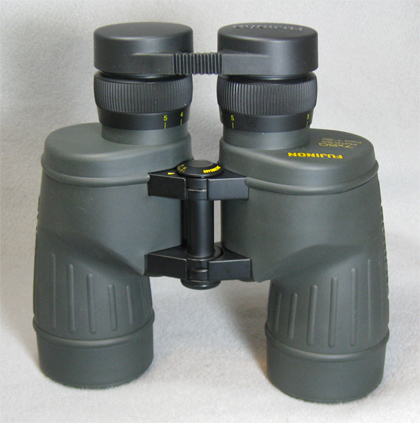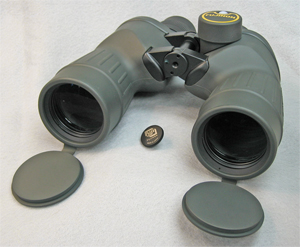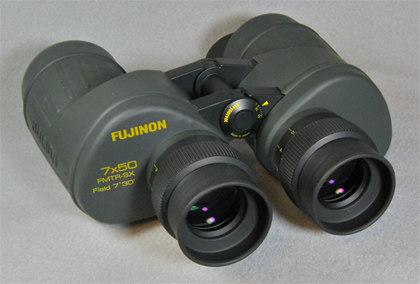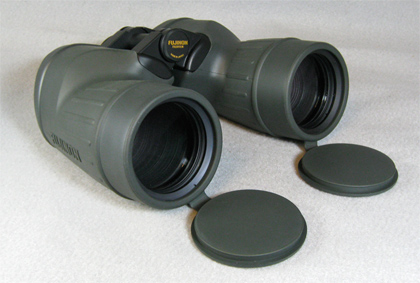Distribution
![]() Fujinon Index Page
Fujinon Index Page
![]() News
News ![]() Notes & Interesting Articles
Notes & Interesting Articles ![]() Pricing
Pricing ![]() Products
Products

Fujinon Polaris 7x 50 mm FMTR-SX Marine Binocular
 The 7x 50 mm FMTR-SX is the cousin of the highly regarded 7x 50 FMT-SX and 7x 50 FMT-SX; these three models are the most popular series of marine hand held 7x 50 binoculars that we sell. These are each a first rate binocular with the 7x 50 mm FMTR-SX adding full rubber covering and with attached objective covers that are so often desired by the mariner. Since introduced in 1987 these are the most sophisticated 50 mm models offered by Fujinon, and offers the best value overall in terms of performance, reliability, and comfort among the best 7x 50 mm binoculars we offer. One would have to look towards one of our Leica, Carl Zeiss, or Nikon binoculars costing twice as much or more to equal or best this binocular, and even then one is not likely to find one with similar comfortable eye relief.
The 7x 50 mm FMTR-SX is the cousin of the highly regarded 7x 50 FMT-SX and 7x 50 FMT-SX; these three models are the most popular series of marine hand held 7x 50 binoculars that we sell. These are each a first rate binocular with the 7x 50 mm FMTR-SX adding full rubber covering and with attached objective covers that are so often desired by the mariner. Since introduced in 1987 these are the most sophisticated 50 mm models offered by Fujinon, and offers the best value overall in terms of performance, reliability, and comfort among the best 7x 50 mm binoculars we offer. One would have to look towards one of our Leica, Carl Zeiss, or Nikon binoculars costing twice as much or more to equal or best this binocular, and even then one is not likely to find one with similar comfortable eye relief.
Customers who visit Company Seven or order these by mail are mightily impressed at what a great value these provide. And those who visit planning to spend less for a boating binocular will find themselves justifying the higher cost of these when measured against the obvious improvements in comfort and performance, and lifetime of service these provide!
Right: Fujinon 7x 50 mm FMTR-SX Binocular (86,170 Bytes).
Click on image to see enlarged view (257,737 bytes)
The Fujinon company is based in Japan and is a well regarded maker of medical, photographic and sports optics products. Their FMT-SX series are their result of years of efforts to perfect a series of binoculars that are suitable for highly demanding marine and astronomical uses. These systems employ a refined doublet objective lens arrangement feeding substantial optical glass (BaK-4) porro prisms and so light fall off or vignetting are among the most modest in production binoculars. These are matched to a very comfortable five element eyepiece. Fujinon's multilayer electron beam deposited antireflection coatings assure a high degree of light throughput, and the elimination of ghost images or glare. The result provides an high degree of contrast, clarity and sharpness across the entire field of view; stars appear as pinpoints against a black velour background of the night sky, a blur coming out of the distant fog is rendered more distinct. The clarity leaves little to be desired, and these feel reassuringly firm in the hand - complemented by their complete rubber non slip coverings.
The balance of magnification and aperture provided by the 7x 50 mm FMTR-SX can make good sense for some pursuing astronomy although the compass will not work when pointed up to the sky. Given the eye's inability to fully dark adapt in suburban areas, the large 7 mm diameter exit pupil provided by this binocular is more practical when used at darker sky sites than in the suburbs. The moderate magnification, combined with outstanding eye relief and large exit pupil makes these a joy to behold even on the less than rock solid deck of a boat. But it's overall convenience, and moderate cost with high performance make it a bargain for astronomers who go to sea nonetheless.
The eyepieces of the FMT series are constructed of five optical glass lens elements providing a field of view with little coma or distortion. All air to glass surfaces of the SX series are E-Beam coated. The eyepiece design provides flat field performance (hence the "F" prefix) with diminished field-curvature. When pointed onto the night sky the stars across most of the field of view are seen as intense pinpoints. And those stars seen toward the extreme periphery while not quite as sharp are clear and not distracting. The capability to image a star as an intense point of is the most difficult test of any optical system, and in fact in production "star tests" using artificial stars (usually a laser light source fed through a tiny perfect pinhole) are quite a common and valid technique for subjectively judging the degree of perfection of a system.
The FMT series display less pincushion distortion than most competing models. One has to work to see what little there is of it - but if you look carefully when panning then a slight bending of the image may appear towards the edges of the field of view. This level of correction comes with some balance of field of view, with a 52 degree apparent field of view, the Fujinon 7x 50 mm FMTR-SX provides a field of view comparable or better than the best other Porro 50 mm models (which range 7. to 7.5 degree). In order to obtain wider actual fields of view, then one would have to consider our Carl Zeiss or Leica roof prism models which even in smaller apertures of 42 mm, these models may cost three times as much as either the 7x 50 mm FMT-SX and FMTR-SX models.
The color correction of the FMTR-SX is quite good too, but then at only 7x this should not be obvious in most better binoculars. When looking at a bright star (Sirius, Vega, etc.) or a black bird on a tree contrasted against a light blue sky, you will not observe any obvious secondary color fringing. The terminator of the Moon for example is sharp, crisp, and three dimensional contrasted against the blackness of space. Buoy's and vessels in the distance are clear and sharp against the blue sky, with no secondary false color fringing.
The optical performance alone could be considered critical features for the demanding mariner, and this is not commonly found with most other binoculars anywhere near this cost. But in addition to the very good optical aspects, there are highly attractive mechanical features:
- Individual Focus: the user initially sets focus by turning each of the two eyepiece housings clockwise or counterclockwise, and once focus is set for infinity then there is no need to fiddle with it. It is possible to adjust each independently and so if you have normal vision, then you may set "0" on the dial. Or if you have prescription glasses with one eye -1.5 and another +2 then it is a simple matter to dial these in on the eyepiece indicator scales and then make fine adjustments as may be needed. The depth of field of focus is so great with these binoculars, that once focused for infinity one may see details on objects as near as about eighty feet without having to focus again.
Thus individual focus eyepieces and mechanical bridge design are helpful considerations for astronomy and shipboard marine use too where one needs to be able to pull the binocular up the eye and see a target in the distance quickly, and without wondering if an object coming out of the fog is in focus or not. The individual focus arrangement facilitates sealing against water and the elements.
"it is reassuring to quickly pickup a binocular to see an object in a moment of stress and know one will not have to fiddle with a conventional (an more vulnerable) dial central focus mechanism - the target will be in focus and as crystal clear as the skies permit" The eye relief (distance from the eyepiece lens to the eye) is 23 mm - unrivaled in this binocular aperture range. The eye relief is adequate for anyone who prefers to wear prescription or sunglasses. To provide that generous balance of eye relief and field of view means the eyepiece are about 50.8 mm (2 inches) in diameter and so those who have wide noses especially if combined with narrow interpupilary spacing may run into trouble. Those wearing glasses can simply roll down the provided eyecups. The rubber eyecups are slipped onto a threaded metal ring, and this assembly threads over the eyepiece; in time these can be replaced easily since they are threaded in place. Their 7 mm exit pupil make this binocular more practical to use for astronomy than those of similar aperture and with smaller exit pupils for those in the urban where their eyes may dilate to accept a large exiting light cone.
The "M" in the designation indicates this is a Fujinon binocular designed for marine use. The FMTR-SX meet the US military specifications for water proofness. This rating is a measure of the binocular's capacity to survive immersion in water at depth for a period of time. Our sense is the binocular will tolerate more shock, vibration and water immersion than the owner will. Furthermore, the metal and alloy materials used in the construction are nonferrous and so the binocular will not distort either the internal or any other nearby magnetic compass.
- The eyepiece focus and the 56 to 74 mm interpupilary (IP) spacing adjustment by pulling the hinged barrels together or apart. These motions are done smoothly with some mild effort, and stay where you leave them set. The seals and lubricants permit focus and IP spacing changes in temperatures ranging from from a low of -20 and + 50 degrees C.
These eyepieces are wide enough that some people with larger noses and narrow IP spacing may not be accommodated. And this is in part why we at Company Seven continue to see the value of a showroom environment where one may visit and try a binocular first hand.
- Tripod Adapter: There is a good amount of area on these to grip comfortably, and to balance well in the hand. However, weighing in at 52.9 ounces these binoculars are quite manageable by an adult of average height and good health. In all fairness, there simply is quite a lot of weight associated with the optical elements needed to provide such good images at this cost. Most amateur astronomers prefer to keep their binocular handy on a neck strap, at the ready to help sight a telescope onto a target or to observer wide expanses of sky however, some will not wish to hand hold a binocular when looking overhead for extended sessions. The solution for the weight issue is the optional Tripod Adapter used with a suitable tripod and head.
 The front of the 7x 50 mm FMTR-SX binocular (Central Axis Bridge) incorporates a ¼ inch - 20 tpi threaded socket which will accept most L bracket style binocular Tripod Adapters. This socket is provided protected by a thread on plastic cover. This hardware option permits one to install the binocular onto typical camera tripod heads. While there are many cheap and simple adapters, poorly engineered adapters made, Company Seven recommends and stocks that adapter made by Fujinon for the FMT-SX/FMTR-SX series. Using this accessory one may leave their binocular fastened onto a suitable tripod and head, or set up conveniently by a window for panoramic uses or for looking at a bird feeder, etc.
The front of the 7x 50 mm FMTR-SX binocular (Central Axis Bridge) incorporates a ¼ inch - 20 tpi threaded socket which will accept most L bracket style binocular Tripod Adapters. This socket is provided protected by a thread on plastic cover. This hardware option permits one to install the binocular onto typical camera tripod heads. While there are many cheap and simple adapters, poorly engineered adapters made, Company Seven recommends and stocks that adapter made by Fujinon for the FMT-SX/FMTR-SX series. Using this accessory one may leave their binocular fastened onto a suitable tripod and head, or set up conveniently by a window for panoramic uses or for looking at a bird feeder, etc.
Left: the similar Fujinon 7x 50 mm FMTRC-SX (compass model) Bridge showing Tripod Adapter socket with protective cover removed (58,379 Bytes).
Click on image to see enlarged view (313,632 bytes)However, most conventional camera tripod alt-azimuth heads do not work well for astronomical applications with binoculars and so for extended astronomical observing sessions Company Seven recommends an articulated parallelogram stand such as our Universal Astronomics UniMount™ Light Deluxe. Such a stand when attached onto a suitable field tripod provides a most comfortable observing experience. Stands such as the UniMount™ do this by allowing the user to position a counter balanced binocular high enough to provide more comfortable head positioning, with some of these stands one could even observe areas overhead while reclined in a lawn chair.
- Filters: The 7x 50 mm FMTR-SX are among the few binoculars made that are able to accept optional filters. To support those who buy the Fujinon binoculars from Company Seven we offer:
- Haze Filters: a nearly transparent appearing filter reduces the haze ("blue blur") or a bluish cast effects caused by UV light during the day especially when observing from high altitudes or from long distances, particularly over water. This filter can be used to protect the eyepieces in harsh climates.
- Binocular Polarizing Filters: to cut the glare from water or snow, the shine from streets or leaves, windows, and enhance color saturation.
- Binocular Nebula Filter (Light Pollution Rejection) Filters: darken the night sky background so that faint nebulae are more easily seen.
- Solar Filters: permit the safe observation of Sun Spots or a Solar Eclipse.
- Haze Filters: a nearly transparent appearing filter reduces the haze ("blue blur") or a bluish cast effects caused by UV light during the day especially when observing from high altitudes or from long distances, particularly over water. This filter can be used to protect the eyepieces in harsh climates.
- Cast alloy construction, sealed with the interior filled with dry nitrogen prohibits fogging or corrosion of the interior optics. Mechanical durability provides longevity. Given reasonable care, then these individual focus FMTR-SX can provide a lifetime of good service that is simply no likely to be matched by similarly priced center focus 50 mm models.
- Baffled and antireflection covered interior construction prevents ghost images and reduces possible effects of glare all accomplished without any loss of contrast or definition. Observations of even the brightest objects (the Moon, etc.) against the background of the night sky show no ghosting or flare.
- Rubber Armor: the exposed mechanical components of the 7x 50 FMTR-SX are covered in a green rubber covering. This makes it easier to hand hold the binocular, especially when wet, in sub freezing environments. The rubber armoring can be replaced in time as needed, though the covers tend to survive decades of routine use.
- Full Rubber Covering: since July 2001 the FMTR-SX binoculars are finished in satin black with a textured greenish-gray rubber covering of the hand held areas, objectives and prism housings. This rubber armoring adds some convenience when handling the binocular in wet environments, or comfort when handling them in extremely cold environments. These keep the appearance of the binocular more intact since they prohibit chipping the anodized and painted areas from becoming chipped or scraped. The contribute some mechanical dampening too.
Right: 7x 50 mm FMTR-SX protective objective covers (61,754 Bytes).
Click on image to see enlarged view (187,090 bytes)The rubber armoring can be replaced in time as needed, though the covers tend to survive decades of routine use. Company Seven can service any Fujinon we sell, and we can replace the FMTR-SX coverings over time if needed. Note, these coverings are not covered under the Fujinon warranty.
- Objective Covers: the FMTR-SX binocular includes captive covers that can snap over the objective lenses to keep them clean (sea spray, etc.) in harsh environments. When observing simply pull on the cap and it will dangle, attached to the binocular by the flexible rubber strap. Company Seven can service any Fujinon we sell, and we can replace the FMTR-SX coverings or the objective caps over time if needed. Note, these coverings are not covered under the Fujinon warranty.
Unlike its conventional cousins there is no hard case provided with the FMTR-SX because of the uncommon profile of the binocular, and since this is considered to be a "self contained" arrangement. However, Company Seven can provide either an optional Fujinon case or an ATA approved custom fit hard shell case.
Below Right: The similar Fujinon 7x 50mm FMTR-SX from observers vantage. Note engraved serial number, I.P scale, comparatively immense eye lens diameter, and robust bridge construction,
The compass is installed atop the left barrel (65,040 Bytes).
Click on image to see enlarged view (189,387 bytes)
7x 50 FMTR-SX Binocular Specifications

| Magnification | 7 X |
|---|---|
| Objective Diameter | 50 mm |
| Twilight Factor † | 18.7 |
| Relative Brightness ‡ | 50.4 |
| Exit Pupil Diameter | 7.14 mm |
| Closest Focus Distance | Appx. 5.0 meters (16.5 ft) |
| Eye Relief | 23 mm |
| I.P. Span | 56 to 74 mm |
| Diopter Accommodation | Between -6 to +6 |
| Actual Field of View | 7° 30¨ (or 7-½) Degrees 131 meters @ 1 km |
| Weight | 1,288 g. (40.8 oz.) |
| Height (Eyecups extended) | 200 mm (7-7/8 inches) |
| Width (typical with IPD at 62mm) | 203 mm (8 inches) |
| Width (maximum) | 218 mm (8.6 inches) |
| Depth (at Prism Housing) | 70 mm (2-¾ inches) |
† Twilight Factor (sometimes termed Relative Brightness) is a mathematical product of a formula. This formula however, does not factor differences of quality. For example two 7x 50 binoculars of vastly differing qualities will produce the same value by using this formula, and so this should only be used to compare binoculars of similar quality (i.e. a Fujinon 7x 50 FMT-SX vs. Fujinon 10x 70 SMT-SX).
-
Twilight Factor = Square Root of (Diameter of Objective Lens x Magnification)
† Relative Brightness (or Relative Light Efficiency) pertains the the efficiency of the optical system in terms of throughput of light. This is measured by sensitive equipment and can help one to determine quality differences between models.
* Specifications are subject to change without notice.
Contents Copyright 1998-2010 Company Seven All Rights Reserved
